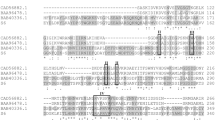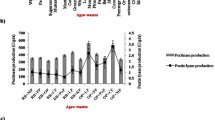Abstract
Pectinase is widely used in numerous industrial fields, including the food, wine, and paper industries. In this work, seven bacteria were isolated from orange peel and their pectinase production activity was assayed. One bacterium (OR-B2) identified as a Bacillus sp. showed the highest enzyme activity towards others. A gene encoding a pectate lyase designed as PelB-B2 in this work was amplified and heterogeneous expressed in E.coli. PelB-B2 was defined as a member of the PelB pectate lyase family after phylogenic tree analysis. 3D model of PelB-B2 was constructed by SWISS-MODEL and PelB-B2 showed conserved para-β structure. After inducing culture and purified by Ni-affinity chromatography, the properties of the purified PelB-B2 were assayed. Optimal pH and temperature for PelB-B2 was pH 8.0 and 50 °C, respectively. PelB-B2 showed excellent pH stability and thermostability. It was stable within pH range 3.0–11.0 and retained more than 51% activity after incubation at 40 °C, 50 °C, or 60 °C for 1 h. Furthermore, we determined that PelB-B2 was a Ca2+-dependent pectinase and the pectin extracted from citrus was the benefit substrate for PelB-B2. The Km and Vmax of PelB-B2 were 1.64 g/L and 232.56 mol/(L min), respectively. The OR-B2 can be a new resource for pectinase production and the PelB-B2 has potential for industrial application.
Graphic abstract
7 bacteria were isolated from orange peel, namely OR-B1 to OR-B7 and their pectinase activities were assayed. One pectate lyase belongs to PelB family was cloned from OR-B2 and heterogeneous expressed in E. coli. Purified PelB-B2 was further studied with its properties. Effects of pH, temperature, chemicals, substrate on the enzyme activity were assayed and the enzyme kinetic was also measured.





Similar content being viewed by others
Change history
15 May 2020
In the original article,
References
Agarwal RP, Thanvi I, Vachhani G, Kochar DK, Rastogi A (1999) Exercise induced proteinuria as an early indicator of diabetic nephropathy. J Assoc Physicians India 46:1127–1128
Alimardani-Theuil P, Gainvors-Claisse A, Duchiron F (2011) Yeasts: an attractive source of pectinases-from gene expression to potential applications: a review. Process Biochem 46:1525–1537. https://doi.org/10.1016/j.procbio.2011.05.010
Alkorta I, GarbisuC LMJ, Serra JL (1998) Industrial applications of pectic enzymes: a review. Process Biochem 33:21–28
Anand G, Yadav S, Yadav D (2017) Production, purification and biochemical characterization of an exo-polygalacturonase from Aspergillusniger MTCC 478 suitable for clarification of orange juice. Biotech 7:122. https://doi.org/10.1007/s13205-017-0760-3
Blanco P, Sieiro C, Reboredo NM, Villa TG (1998) Cloning, molecular characterization, and expression of an endo-polygalacturonase-encoding gene from Saccharomycescerevisiae IM1-8b. Fems Microbiol Lett 164:249–255. https://doi.org/10.1111/j1574-6968.1998.tb13094.x
Chen P, Zhu Y, Men Y, Zeng Y, Sun Y (2018) Purification and characterization of a novel alginate lyase from the marine Bacterium bacillus sp. Alg07. Mar Drugs 16:86. https://doi.org/10.3390/md16030086
Gainvors A, Karam N, Lequart C, Belarbi A (1994) Use of Saccharomycescerevisiae for the clarification of fruit juices. Biotechnol Lett 16:1329–1334. https://doi.org/10.1007/BF00149641
Guan Y, Yin D, Du X, Ye X (2018a) Functional metabolomics approach reveals the reduced biosynthesis of fatty acids and TCA cycle is required for pectinase activity in Bacilluslicheniformis. J Ind Microbiol Biotechnol 45:951–960. https://doi.org/10.1007/s10295-018-2071-z
Guan Y, Yin D, Du X, Ye X (2018b) Metabolomics approach used for understanding temperature-related pectinase activity in Bacillus licheniformis DY2. Fems Microbiol Lett 365:23. https://doi.org/10.1093/femsle/fny255
Henrissat B, Bairoch A (1993) New families in the classification of glycosyl hydrolases based on amino acid sequence similarities. Biochem J 293:781–788. https://doi.org/10.1042/bj2930781
Hero JS, Pisa JH, Perotti NI, Romero CM, Martínez MA (2017) Endoglucanase and xylanase production by Bacillus sp. AR03 in Co-Culture. Prep Biochem Biotechnol 47:589–596. https://doi.org/10.1080/10826068.2017.1280826
Hugouvieux-Cotte-Pattat NCG, Nasser W, Reverchon S (1996) Regulation of pectinolysisin Erwiniachrysanthemi. Annu Rev Microbiol 50:213–257. https://doi.org/10.1146/annurev.micro.50.1.213
Jayani RS, Saxena S, Gupta R (2005) Microbial pectinolytic enzymes: a review. Process Biochem 40:2931–2944. https://doi.org/10.1016/j.procbio.2005.03.026
Ju Z (2011) Research progress on pectinase from bacteria. Biotechnol Bull 2:56–60
Kashyap DR, Vohra PK, Chopra S, Tewari R (2001) Applications of pectinases in the commercial sector: a review. Bioresour Technol 77:215–227
Kaur SJ, Gupta VK (2017) Production of pectinolytic enzymes pectinase and pectin lyase by Bacillussubtilis SAV-21 in solid state fermentation. Ann Microbiol 67:333–342. https://doi.org/10.1007/s13213-017-1264-4
Kertesz ZI (1955) Pectic enzymes. Methods Enzymol 1:158–166
Lerouxel O, Cavalier DM, Liepman AH, Keegstra K (2006) Biosynthesis of plant cell wall polysaccharides—a complex process. Curr Opin Plant Biol 9:621–630
Li ZM, Bai ZH, Zhang BG, Li BJ, Jin B, Zhang M, Lin F, Zhang HX (2012) Purification and characterization of alkaline pectin lyase from a newly isolated Bacillusclausii and its application in elicitation of plant disease resistance. Appl Biochem Biotechnol 167:2241–2256. https://doi.org/10.1007/s12010-012-9758-9
Muroi F, Tachibana Y, Soulenthone P, Yamamoto K, Mizuno T, Sakurai T, Kobayashi Y, Kasuya KI (2017) Characterization of a poly(butylene adipate-co-terephthalate) hydrolase from the aerobic mesophilic bacterium Bacilluspumilus. Polym Degrad Stab 137:11–22. https://doi.org/10.1016/j.polymdegradstab.2017.01.006
Peng Y, Meng K, Luo H, Shi P, Huang H, Bai Y, Yang P, Yao B (2011) A novel low-temperature active alkaline pectate lyase from Klebsiella sp. Y1 with potential in textile industry. Process Biochem 46:1921–1926. https://doi.org/10.1016/j.procbio.2011.06.023
Pretel MT, Lozano P, Riquelme F, Romojaro F (1997) Pectic enzymes in fresh fruit processing: optimization of enzymic peeling of oranges. Process Biochem 32:43–49
Rashmi RMK, Sneha G, Shabana S, Syama A, Radhika VS (2008) Partial purification and biochemical characterization of extracellular pectinase from Aspergillusniger isolated from groundnut seeds. J Appl Biosci 9:378–384
Reginatto C, Rossi C, Miglioranza BG, Santos MD, Meneghel L, Silveira MMD, Malvessi E (2017) Pectinase production by Aspergillusniger LB-02-SF is influenced by the culture medium composition and the addition of the enzyme inducer after biomass growth. Process Biochem 58:1–8. https://doi.org/10.1016/j.procbio.2017.04.018
Roosdiana A, Prasetyawan S, Mahdi C, Sutrisno X (2013) Production and characterization of Bacillus firmus pectinase. J Pure Appl Chem Res 2:35–41. https://doi.org/10.21776/ub.jpacr.2013.002.01.111
Rubio MJ, Roberto C, Rubio FA, Fernando RJ (2005) Continuous enzymatic precooking for the production of an instant corn flour for snack and tortilla. EP 1:242–545.
Sakai T, Sakamoto T, Hallaert J, Vandamme EJ (1993) Pectin, pectinase, and protopectinase—production, properties, and applications. Adv Appl Microbiol 39:213–294
Saranraj P, Naidu MA (2014) Microbial pectinases: a review. Glob J Trad Med Syst 3:1–9
Siddiqui MA, Pande V, Arif M (2012) Production, purification, and characterization of polygalacturonase from Rhizomucorpusillus isolated from decomposting orange peels. Enzyme Res 9:138634. https://doi.org/10.1155/2012/138634
Soumpourou E, Lakovidis M, Chartrain L, Lyall V, Thomas CM (2007) The Solanumpimpinellifolium Cf-ECP1 and Cf-ECP4 genes for resistance to Cladosporiumfulvam are located at the Milky Way locus on the short arm of chromosome 1. Theor Appl Genet 115:1127–1136. https://doi.org/10.1007/s00122-007-0638-6
Sun L, Cao J, Liu Y, Wang J, Guo P, Wang Z (2017) Gene cloning and expression of cellulase of Bacillusamyloliquefaciens isolated from the cecum of goose. Anim Biotechnol 28:74–82. https://doi.org/10.1080/10495398.2016.1205594
Tapre AR, Jain RK (2014) Pectinases: enzymes for fruit processing industry. Int Food Res J 21:447–453
Thite VS, Nerurkar AS (2018) Physicochemical characterization of pectinase activity from Bacillus spp. and their accessory role in synergism with crude xylanase and commercial cellulase in enzyme cocktail mediated saccharification of agrowaste biomass. J Appl Microbiol 124:1147–1163. https://doi.org/10.1111/jam.13718
Wang H, Li X, Ma Y, Song J (2014) Characterization and high-level expression of a metagenome-derived alkaline pectate lyase in recombinant Escherichiacoli. Process Biochem 49:69–76
Yildirim V, Baltaci MO, Ozgencli I, Şişecioğlu M, Adiguzel A, Adiguzel G (2017) Purification and biochemical characterization of a novel thermostable serine alkaline protease from Aeribacilluspallidus C10: a potential additive for detergents. J Enzyme Inhib Med Chem 32:468–477. https://doi.org/10.1080/14756366.2016.1261131
Zhou C, Xue Y, Ma Y (2017a) Cloning, evaluation, and high-level expression of a thermo-alkaline pectate lyase from alkaliphilic Bacillusclausii with potential in ramie degumming. Appl Microbiol Biotechnol 101:3663–3676. https://doi.org/10.1007/s00253-017-8110-2
Zhou M, Wu J, Wang T, Gao L, Yin H, Xin L (2017b) The purification and characterization of a novel alkali-stable pectate lyase produced by Bacillussubtilis PB1. World J Microbiol Biotechnol 33:190. https://doi.org/10.1007/s11274-017-2357-8
Acknowledgements
The authors would like to thank Gale A. Kirking at English Editorial Services, s.r.o. for language correction and additional assistance in improving the text.
Funding
This work was supported by National Natural Science Foundation of China (31701844), Natural Science Foundation of Fujian province (2018J05057), the Foundation of Fujian Educational Bureau (JAT170078), Fuzhou University Testing Fund of precious apparatus (2019T018), and with institutional support RVO: 60077344 of the Biology Centre CAS, Institute of Entomology, Czech Republic.
Author information
Authors and Affiliations
Contributions
YG, DW, CL, YZ, IG, and XY contributed equally to the study design, collection of data, development of the sampling, analyses, interpretation of results, and preparation of the paper. All authors read and approved the final manuscript.
Corresponding authors
Ethics declarations
Conflict of interest
The authors declare no conflicts of interest.
Ethical statement
No special permit was required for this work.
Additional information
Communicated by Erko Stackebrandt.
Publisher's Note
Springer Nature remains neutral with regard to jurisdictional claims in published maps and institutional affiliations.
Electronic supplementary material
Below is the link to the electronic supplementary material.
Rights and permissions
About this article
Cite this article
Guan, Y., Wang, D., Lv, C. et al. Archives of microbiology: screening of pectinase-producing bacteria from citrus peel and characterization of a recombinant pectate lyase with applied potential. Arch Microbiol 202, 1005–1013 (2020). https://doi.org/10.1007/s00203-020-01807-0
Received:
Revised:
Accepted:
Published:
Issue Date:
DOI: https://doi.org/10.1007/s00203-020-01807-0




